Dr Andrea Zerbini: In Memoriam
Dr Robert Bewley writes
To keep the memory of our recently departed and dear friend Andrea Zerbini fresh the EAMENA team would like to share our memories and photos of the time he worked with us from 2015 to 2018, in Oxford. He started as one of the first researchers, analysing satellite imagery, creating records of archaeological sites in his beloved Jordan (and Robyn reminds us of his repeated and uncanny ability to spot vineyards and wine making sites from aerial photos), and he played a large part in the Madaba Ring-Road project. In time he played a key role in the design and nature of the EAMENA database; eventually becoming the IT/GIS officer for the project – effectively the database manager, as he let slip that as a teenager he had done some computer coding (as a side-line to his passion for archaeology). Somehow Andrea was that person who could offer exactly the skills we needed for the project, exactly when we most urgently needed them. We are eternally grateful for his intelligence, inspiration, creativity and dedication.

One of the very first EAMENA team meetings in 2015.
The tribute for Andrea by his current employer (CBRL) can be found in the following link CBRL Obituary and the Global Heritage Fund tribute.
Our purpose here is to add to the description of Andrea’s achievements with some personal stories and memories. We are immensely grateful to his mother, Mrs Paola Donati da Silva, for sharing this story about Andrea’s early life and the photo of him as a young boy.
‘I also have a degree in Archaeology and since he was little Andrea became really passionate about ancient Egypt. One evening, after having spent sometimes in his room in a rather worrying silence, he came out wearing a long old shawl reaching his feet and a sort of turban on his head. Serious, almost hieratic he said: “Mummy something has changed inside of me. I have become a Tutankhamon priest and our life will not be the same, because I now have obligations towards my Pharaoh”. I instinctively followed his desire and kneeled down swearing loyalty. I thought it was over and the following days he would have become again the usual 6 year old boy. Instead, he did not! For at least a month, every time that someone was coming to visit us, we all had to pay tribute to the Pharaoh attending the ceremony presided by his priest.
‘Or maybe I should remember the time when in Metaponto we descended into a 2 meter deep moat because we could see archaeological materials. The problem was that the farmer had just burnt the stubble in there and Andrea came out fully covered in ashes, like a chimney sweep, but proud of his little pottery sherds.
‘This is how Andrea was curious, passionate about learning and knowing.
‘Andrea has asked that on his grave stone we write the Dante’s words from the Divina Commedia:
‘Fatti non foste a viver come bruti,
Ma per seguir virtude e conoscenza’
(You were not made to live like brutes / but to follow virtue and knowledge)’
Paola Donati Da Silva (Andrea’s mum) [With thanks to Anna Leone and Francesca Radcliffe for their translations]
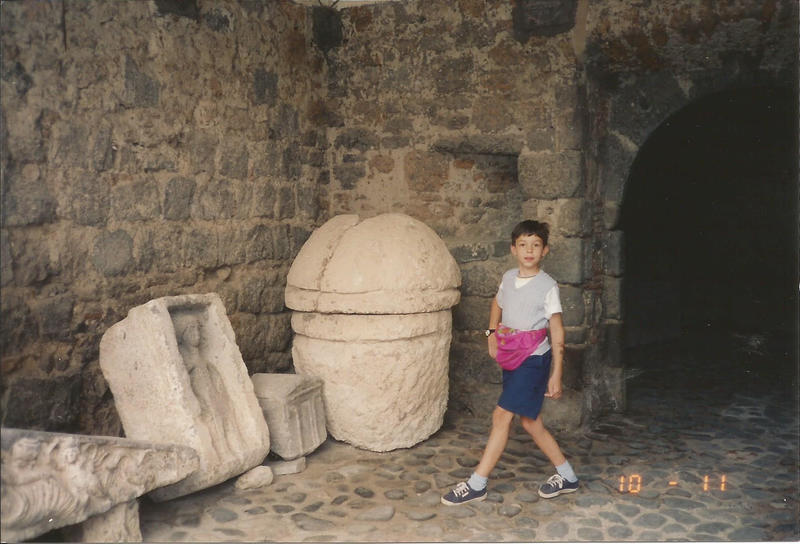
Andrea as a young boy.
We only came to know Andrea in his adult life and his personality shone through at all times of the day and night; there were many evenings we would know he was still busy at work because of the gentle lights shining from his ‘four’screens Zerbini’ desk. He was always the best dressed, most stylish attendee at any event and his infectious smile and lust for life made everyone feel so at ease.
Coffee was one of his many passions and, with his friend and colleague Michael Fradley, an internal (non-commercial) enterprise, in fact a social enterprise was created: Fradini’s [patent pending] with its own branded coffee cups. Fradini’s is still going strong, but we know his coffee-passion continued in Amman as he shipped various machines and coffee making equipment there with him.
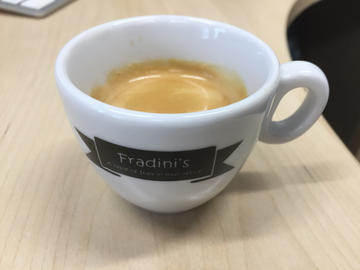
Bob Bewley remembers: Andrea’s contribution to the EAMENA project was immense; not just his drive and dedication but also his knowledge of archaeology, the Middle East, Arabic and yes, computers and coding, and his passion was for research and discovery. When he left the EAMENA project to join CBRL I had an idea, a hope he would, one day soon, take over the running of the aerial archaeology project in Jordan He first flew with us in 2015, the last season of the Huey helicopters. In true Andrea fashion, having been asked to sit in the jump seat, which normally faced forward (so a poor view) – he asked if the seat could be turned through 90 degrees; in 5 minutes this was done; after 20 years of having asked willing passengers to sit ‘uncomfortably’, Andrea had solved the problem; this was one of his great strengths – finding solutions.
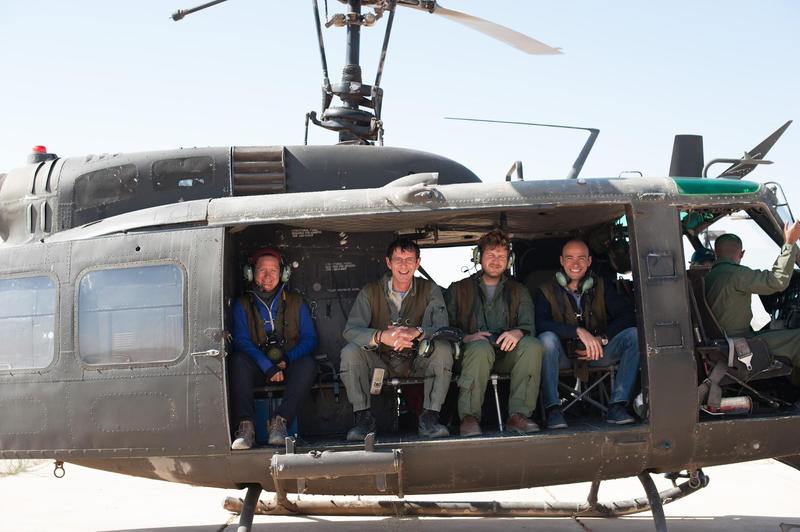
Andrea and the team on one of the last flights in the Huey. © APAAME_20151001-0240

Andrea in discovery mode. © APAAME 20160529-0156
One of my lasting memories will be the last flight we took together in Jordan (with Mat Dalton and Firas Bqa’in). Pre-flight we ensured we all had cameras and I gave Andrea the project’s Nikon D750 and he lent Firas his Canon. The purpose of the trip was to photograph sites in northern Jordan, starting at Umm el Jimal, but then focusing on much smaller targets than a whole city; Andrea was looking for olive presses and anything associated with them, often he would record a hole in a rock – perhaps a press or a cistern? He was sitting on the floor by the open door so had the opportunity to photograph, almost vertically down, any small feature that took his fancy. A real challenge when it came to cataloguing these photographs but his desire for discovery was undiminished. However the point of the story was that after two hours, we had to refuel the helicopter and Firas announced that he’d filled his memory card (over 1,000 images) – and I was dumbstruck; in all the years we had been flying no-one had ever taken so many pictures in such a short time. A back-up card was found, but it took a while longer to find out what had been happening. The Canon (Andrea’s camera) was set to “burst” mode. I hadn’t thought to check it, and now, thinking back to Andrea’s life this was a perfect example of how he lived his life – on burst mode.
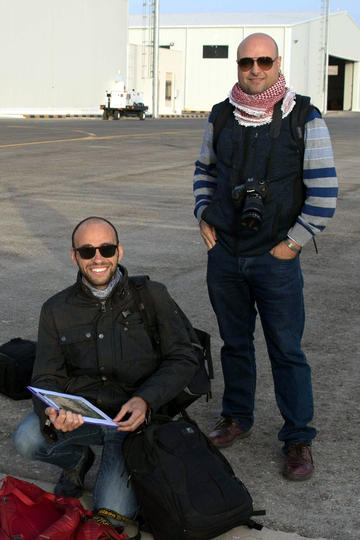
Getting ready for the flight 22nd October 2018. © APAAME
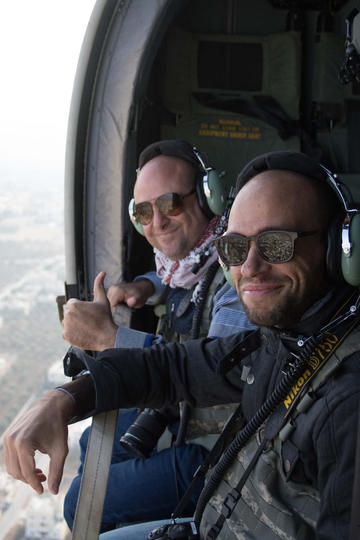
Andrea and Firas 22nd October 2018. © APAAME
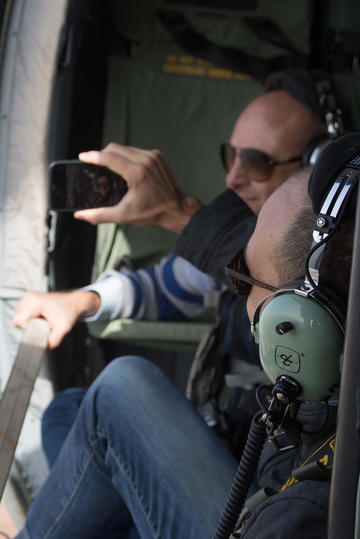
Andrea taking a selfie in the helicopter 22nd October 2018. © APAAME
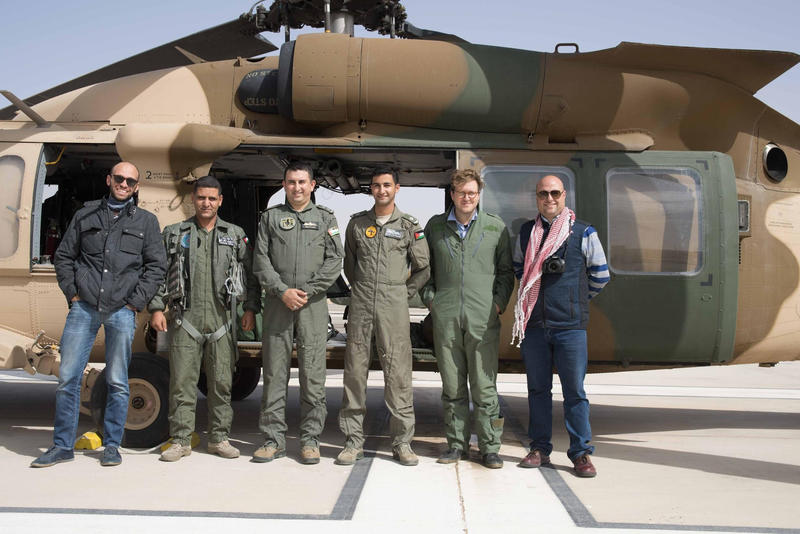
The post-flight team photo. 22nd October 2018. © APAAME
Another time he came to me with the idea that we create a conference series, to be associated with the EAMENA project but also separate from it. This seemed a very good thing to be doing – but did we have the time? No matter – he brought his colleagues along with him, made several applications for funds and in October 2015 the first of the series was held in Amman, Jordan. Since then they have been held in Sulaimania, Iraq (2016), Tunis (2017), and Sharjah (2018). The 5th conference, in December 2019 will be dedicated to Andrea’s memory in Agadir, Morocco.
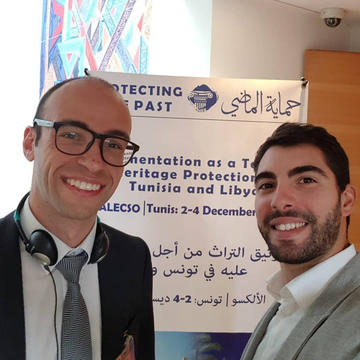
Andrea e Pierfrancesco a Tunisi nel 2017.
Michael Fradley remembers
Andrea and I had already become good friends through Fradini’s coffee, which started with Andrea teaching me how to make the perfect espresso, and descending into the slightly competitive acquisition of single origin coffees, buying a grinder and one occasion where I accidentally bought some unroasted Yemeni coffee beans and had to learn to roast, with very mixed results. Pushing forward the project work over Yemen was another key area where we came together, but it is our work in early 2017 investigating an obscure piece of U.S legislation that really sticks in my mind when I think of our time working together. The Kyl-Bingaman Amendment was an obscure U.S. law that prohibited access to high-resolution satellite imagery of Israel and Palestine, and was a major impediment to the work the project would be undertaking with colleagues from Palestine. There was little written about the subject, but we felt that this was something we needed to follow up, and we both jumped on it. For various reasons it was deemed a bit controversial, and not really the realm of two archaeologists, so we had to work on it in the evenings. Every morning we would meet at the espresso machine, talking giddily about the new leads we had discovered, contacts we had made and new insights that we had brought to the table. For a moment it was as though we were keen investigative journalists from the ‘70s, uncovering a government conspiracy, although sartorially it was only Andrea who could pull this look off. After two weeks of this we had pulled together a paper that shone a light on this issue, and opened a path that would hopefully see the law reformed and this censorship ended. We were immensely proud of the work that we had done, but just as much, and maybe even more so now, I remember the overwhelming sense of fun we had as Andrea’s inquisitive nature, and his belief in the need to make knowledge open to all, led us to pursue this little adventure.
Louise Rayne remembers
that every time I arrived in the Oxford EAMENA office, tired after a long train journey, Andrea would straight away make me a nice espresso. Then I used to enjoy going for a falafel wrap with Andrea and chatting about GIS. Whenever I stayed with Andrea and Robyn at their house in Oxford, Andrea used to make me a proper breakfast which was nice because I don’t normally get round to making breakfast. Since then if ever I have a proper breakfast, I think of Andrea.
Pascal Flohr remembers:
I met Andrea first in Jordan maybe 5 years ago, but only really got to know him when I started working for EAMENA, where my first desk was next to his. We shared a love for Jordan, its people and heritage alike. Like many others in the team, I did not really drink espresso before I started working for EAMENA and was introduced to Andrea’s espresso rounds. While initially I felt bad for him that so often he was the one making coffee, I soon realised it was actually a disappointment to him when someone declined! I learned so much from working with Andrea. The main thing is not about work really, but to make the most of life and enjoy each day, and not wait for the future to do this. He had so many plans and ideas, and he did them too: his amazing car journey to Mongolia and back, or moving back to Jordan because he had loved it there so much.
He combined the unique combination of knowledge of (Near Eastern) archaeology and IT/database skills, with of the two archaeology being more of a passion for him I think, but he was brilliant at both. Combining these, Andrea initiated the Mapping Digital Heritage in Jordan (MaDiH) project, in which I was and am involved. In one of the early meetings we said one of the aims of this project really was to create more Andreas! You can also tell about his love for the Arabic language, as we wanted to make sure that the acronym would mean something good in Arabic (MaDiH means to praise). It is a daunting task to do this project without his advice, but the whole team is determined to do him proud.
Many of the team have commented on how it was impossible to say ‘No’ to him; Mike Bishop on becoming an espresso drinker – only because of Andrea’s offer of coffee with the words “Go on, you know you want one..”. When Andrea asked if he could go on the Mongol rally – the immediate reaction was – “absolutely not – we need you here, you’re a key player in the project and anyway it’s a crazy idea… and in a Fiat Panda”. But with his persuasive powers, and saying that it was ‘over the summer’ – we relented and he had a great time.
Andrea’s inquisitive nature, passion for the Middle East and his infinite generosity will continue to inspire future travellers and students through his Education and Travel Foundation.
Bijan Rouhni remembers:
I met Andrea before I joined the EAMENA project. It was enough to meet him just for a few minutes to feel you know him for a long long time. And starting a friendship was something that he was always ready for it.
I was invited to give a paper at Protecting the Past (PtP) Conference in 2016 in Iraq, and although I was not working for the EAMENA yet, soon I felt I was a member. Protecting the Past was one of his ideas to create a platform for discussing cultural heritage management issues in the Middle East and North Africa. It became one of our important and good things to do together, among many other ‘dreams’ for the future. He was very happy to see that the conference was growing and becoming well established. It was during Protecting the Past 2018 in Sharjah when he felt unwell and was diagnosed a few days later when he went back to Amman.
When he wanted to leave the EAMENA project to take his new position at CBRL in Amman, I was sad. But his enthusiasm for doing more and his love for Jordan convinced me that it was the right decision. When he was in Jordan, we had video calls every week. He used to show me the Sun from his window and the grapes that they had in the small garden of the British Institute.
When he wanted to go on Mongol Rally 2017, he asked me about a few places in Iran to visit. I introduced him some landmarks but also asked him to visit Zendan-e-Soleiman (Solomon’s Prison), if he was going to be in Azerbaijan province. It is an ancient volcano which rises about 100 m above its surroundings, and it is very close to the World Heritage Site of Takht-e-Soleiman (Solomon’s Throne). In July 2017, exactly two years before he left us, he sent me a selfie from Iran, showing on the top of the volcano.
In Persian, ‘Jaan’ (‘Joon’ in Tehrani accent) means ‘dear’, but you never use it without a name. He used to call me ‘joon’, and I always told him: “Look, Andrea! In Persian, you should say Bijan joon! You cannot just use it alone, it’s not nice”. But then he repeated it louder and louder: “Hey Joooon! Hey Joooon! Are you ready for another coffee? Are you ready for another PtP?”
I still listen to his voice messages, calling me ‘jooon’ with his unforgettable smile from the top of the extinct volcano.
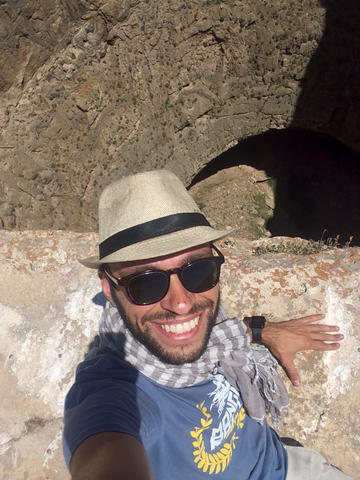
Andrea on top of the extinct volcano of Zendan-e-Soleiman, Iran, July 2017
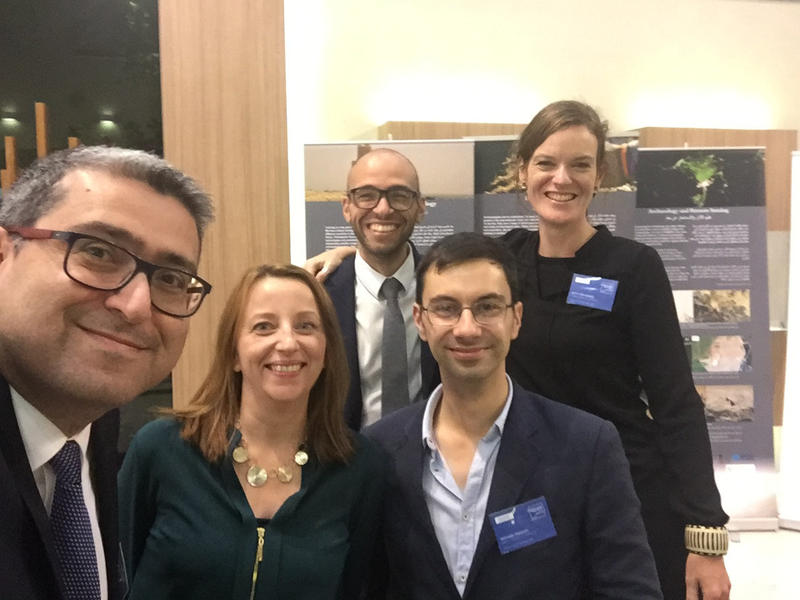
Protecting the Past Conference, Sharjah, UAE, 4 December 2018.
Letty ten Harkel remembers:
I had the pleasure of working with Andrea since September 2016, when I joined the EAMENA team. My overwhelming memory of him is how he was always busy, but always had time to help others. I was new to the archaeology of the MENA region, and no matter the demands of the EAMENA database or the extensive list of research questions he was pursuing (often after hours), he always answered my questions – about the archaeology of the region or about learning Arabic – with great enthusiasm, or found time just to have a chat when I popped in to say goodbye at the end of the day. Once, he even set a whole afternoon apart to explain the ARCHES database system in detail to a friend of mine he did not really know, because she was applying for a job that required knowledge of this system. And he always offered espresso, even though I always declined – my north European stomach being too used to watered down filter coffee to be able to deal with Fradini’s strong brew – somehow he found it impossible to believe that I could so persistently disappoint him!
I got to know Andrea best just a short time before he fell ill, at the 2018 Protecting the Past conference in Sharjah, where he taught me to drive like an Emirati in our big white hire car, and was remarkably patient with me each time I accidentally took the wrong route – or sent him down the wrong route when I was navigating – in the busy traffic between Dubai and Sharjah. What struck me most there was his enjoyment at being in the Middle East with a large group of like-minded people, exploring new things like the Abu Dhabi Louvre and Art Jameel in Dubai, and his modesty – even though he was the brains behind the conference series it took some persuading for him to get on stage and do the conference summing up!
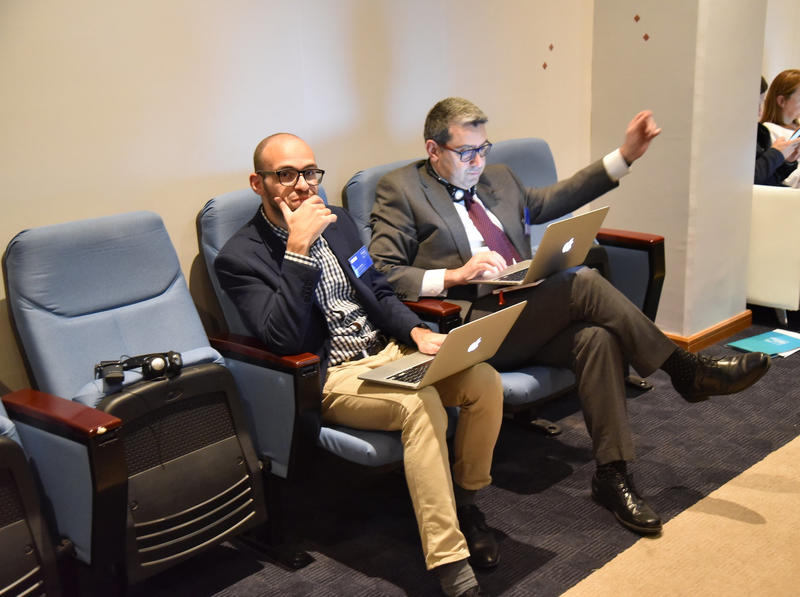
Andrea taking a back-seat role during the 2018 Protecting the Past Conference (with Bijan seemingly conducting..).

Andrea enjoying an installation at the Jameel Arts Centre in Dubai during the 2018 Protecting the Past Conference Cultural Tour.
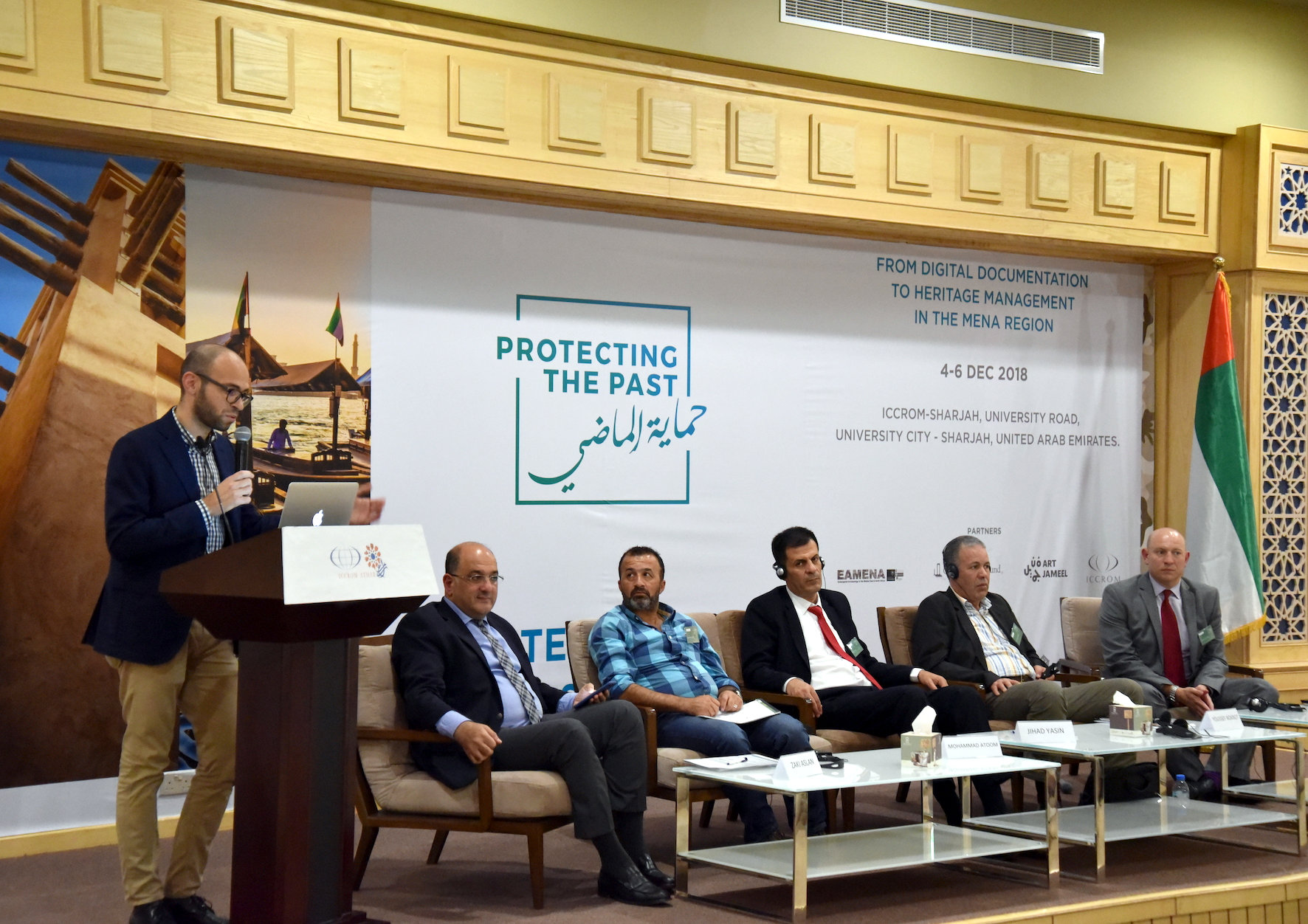
Andrea summing up during the 2018 Protecting the Past Conference.
It is perhaps fitting to conclude these tributes to Andrea with this image, as I think this was his last public appearance before being taken ill.
No-one who ever met him and worked with him will ever forget him.



